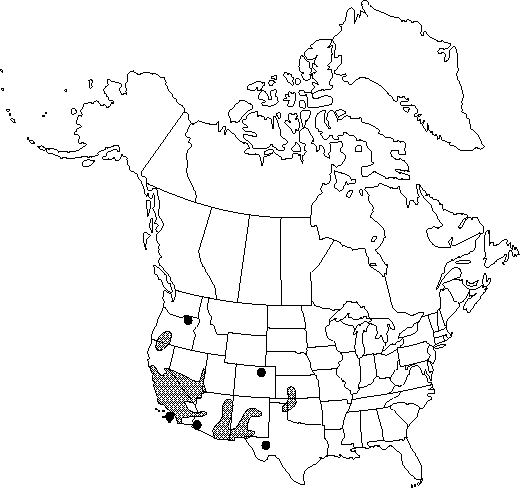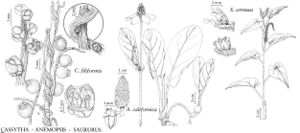Difference between revisions of "Anemopsis californica"
Bot. Beechey Voy., 390. 1841.
FNA>Volume Importer |
FNA>Volume Importer |
||
| Line 26: | Line 26: | ||
}}<!-- | }}<!-- | ||
| − | --><span class="statement" id="st- | + | --><span class="statement" id="st-undefined" data-properties=""><b>Herbs,</b> 8-80 cm, densely pubescent to nearly glabrous, producing stolons. <b>Basal</b> leaves 5-60 cm; petiole 2-40 cm; blade elliptic-oblong, 1-25 × 1-12 cm, base cordate to obtuse, apex rounded. <b>Cauline</b> leaves dimorphic; primary leaf 1(-2), usually bearing secondary leaves in axil; blade sessile, broadly to narrowly ovate, 1-9 × 1-4 cm, base clasping, apex rounded to acute. <b>Secondary</b> leaves 1-4, 2-20 cm; petiole 1-12 cm; blade elliptic-oblong, 2-10 × 1-5 cm, base cordate to rounded, apex rounded to acute. <b>Spikes</b> erect, fragrant, conic, 1-4 cm, subtended by bracts; bracts 4-9, white to reddish, petaloid, 5-35 × 5-15 mm. <b>Floral</b> bracts white, ± orbiculate, 3.5-6 mm (distinct portion), clawed, each adnate to an ovary. <b>Capsules</b> brown, 5-7 mm, coalescent but easily separable. <b>Seeds</b> brown, 1-1.5 × 0.8-1 mm, reticulate. <b>2n</b> = 22.</span><!-- |
-->{{Treatment/Body | -->{{Treatment/Body | ||
| Line 32: | Line 32: | ||
|habitat=Wet, alkaline, saline, and coastal marsh areas | |habitat=Wet, alkaline, saline, and coastal marsh areas | ||
|elevation=0-2000 m | |elevation=0-2000 m | ||
| − | |distribution=Ariz.;Calif.;Colo.;Kans.;Nev.;N.Mex.;Okla.;Oreg.;Tex.;Utah;n Mexico | + | |distribution=Ariz.;Calif.;Colo.;Kans.;Nev.;N.Mex.;Okla.;Oreg.;Tex.;Utah;n Mexico. |
|discussion=<p>Some American Indians used Anemopsis californica for a variety of medicinal purposes (D. E. Moerman 1986).</p> | |discussion=<p>Some American Indians used Anemopsis californica for a variety of medicinal purposes (D. E. Moerman 1986).</p> | ||
|tables= | |tables= | ||
| Line 52: | Line 52: | ||
|habitat=Wet, alkaline, saline, and coastal marsh areas | |habitat=Wet, alkaline, saline, and coastal marsh areas | ||
|elevation=0-2000 m | |elevation=0-2000 m | ||
| − | |distribution=Ariz.;Calif.;Colo.;Kans.;Nev.;N.Mex.;Okla.;Oreg.;Tex.;Utah;n Mexico | + | |distribution=Ariz.;Calif.;Colo.;Kans.;Nev.;N.Mex.;Okla.;Oreg.;Tex.;Utah;n Mexico. |
|reference=None | |reference=None | ||
|publication title=Bot. Beechey Voy., | |publication title=Bot. Beechey Voy., | ||
|publication year=1841 | |publication year=1841 | ||
|special status=Selected by author to be illustrated;Weedy | |special status=Selected by author to be illustrated;Weedy | ||
| − | |source xml=https://jpend@bitbucket.org/aafc-mbb/fna- | + | |source xml=https://jpend@bitbucket.org/aafc-mbb/fna-data-curation.git/src/9216fc802291cd3df363fd52122300479582ede7/coarse_grained_fna_xml/V3/V3_38.xml |
|genus=Anemopsis | |genus=Anemopsis | ||
|species=Anemopsis californica | |species=Anemopsis californica | ||
| − | |||
| − | |||
| − | |||
| − | |||
| − | |||
| − | |||
| − | |||
| − | |||
| − | |||
| − | |||
| − | |||
| − | |||
| − | |||
| − | |||
| − | |||
| − | |||
| − | |||
| − | |||
| − | |||
| − | |||
| − | |||
| − | |||
| − | |||
| − | |||
| − | |||
| − | |||
| − | |||
| − | |||
| − | |||
| − | |||
| − | |||
| − | |||
| − | |||
| − | |||
| − | |||
| − | |||
| − | |||
| − | |||
}}<!-- | }}<!-- | ||
-->[[Category:Treatment]][[Category:Anemopsis]] | -->[[Category:Treatment]][[Category:Anemopsis]] | ||
Revision as of 13:39, 27 July 2019
Herbs, 8-80 cm, densely pubescent to nearly glabrous, producing stolons. Basal leaves 5-60 cm; petiole 2-40 cm; blade elliptic-oblong, 1-25 × 1-12 cm, base cordate to obtuse, apex rounded. Cauline leaves dimorphic; primary leaf 1(-2), usually bearing secondary leaves in axil; blade sessile, broadly to narrowly ovate, 1-9 × 1-4 cm, base clasping, apex rounded to acute. Secondary leaves 1-4, 2-20 cm; petiole 1-12 cm; blade elliptic-oblong, 2-10 × 1-5 cm, base cordate to rounded, apex rounded to acute. Spikes erect, fragrant, conic, 1-4 cm, subtended by bracts; bracts 4-9, white to reddish, petaloid, 5-35 × 5-15 mm. Floral bracts white, ± orbiculate, 3.5-6 mm (distinct portion), clawed, each adnate to an ovary. Capsules brown, 5-7 mm, coalescent but easily separable. Seeds brown, 1-1.5 × 0.8-1 mm, reticulate. 2n = 22.
Phenology: Flowering early spring–summer.
Habitat: Wet, alkaline, saline, and coastal marsh areas
Elevation: 0-2000 m
Distribution

Ariz., Calif., Colo., Kans., Nev., N.Mex., Okla., Oreg., Tex., Utah, n Mexico.
Discussion
Some American Indians used Anemopsis californica for a variety of medicinal purposes (D. E. Moerman 1986).
Selected References
None.
